Instruct your People (Leading your Startup through CRISIS Step #3)
Instruct your people. Tell everyone what you want them to do right now, even if you’re not quite sure how things will pan out in the long run
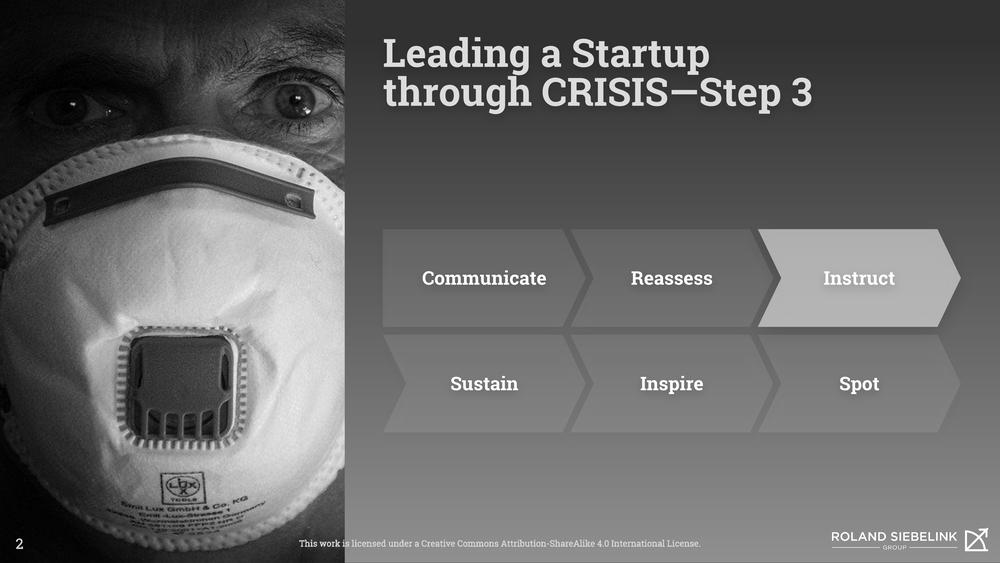
The third step in our C.R.I.S.I.S. framework, for leading your startup through crisis, is “Instruct your People.” It is about giving clarity to people what you want them to do right now, even if all your plans for the future may be up in arms and you may have to come up with new action plans over time. Don’t leave people hanging. That’s what we’re trying to say.
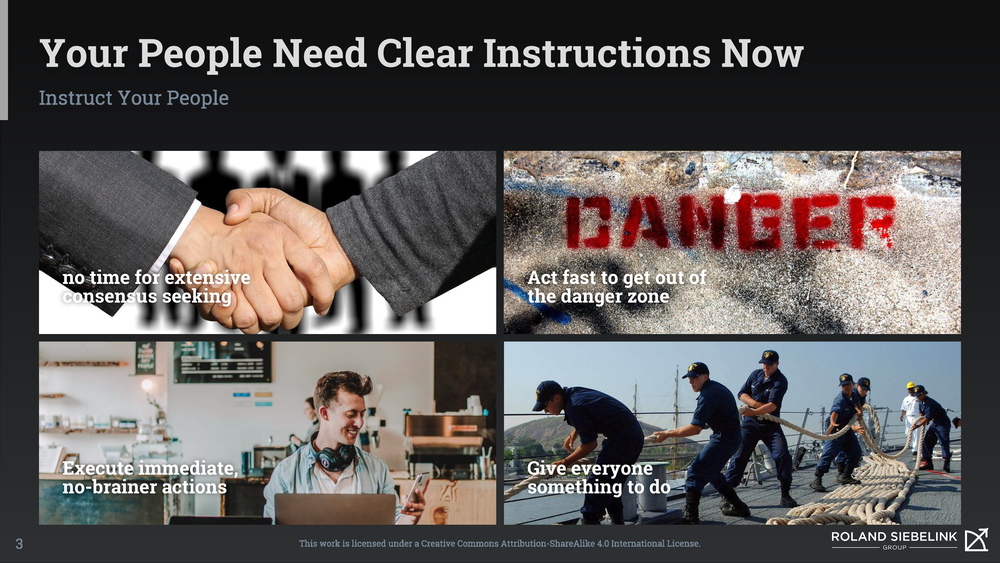
This third step in our C.R.I.S.I.S. framework, we’ve divided up in four key areas.
-
Understand that this is no time for extensive consensus seeking.
-
Act fast to get out of the danger zone.
-
Execute immediate, no-brainer actions.
-
Give everyone something to do.
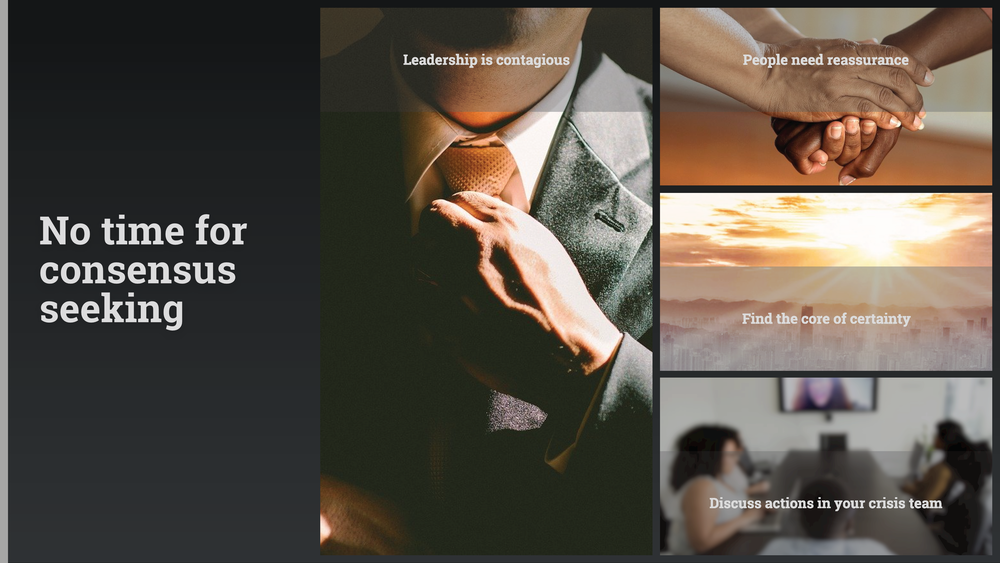
No time for extensive consensus seeking. Understand that this is a wartime situation where people want you to take forceful leadership decisions. And want the security that their leadership provides.
Leadership is contagious
Leadership, or the lack of it, is as contagious here as a virus may well be. If you project a lot of uncertainty, a lot of other people in the company will become uncertain too. If you project certainty, show the things you are certain about, tell everyone very clearly what you want them to do, you will see leaders stepping up all around you. And the company will get to a state where even the board says: “Wow, I’ve never seen a company deal with a crisis so well.”
People need reassurance
People need that reassurance from you, and that’s your core job as a leader. To reassure them about the things we can still be certain about, even if you’re honest and open about the things we don’t quite know yet.
Find the core of certainty
That’s why I recommend to find the very core of certainty you still have. So even in an environment such as a big economic crisis, where there’s a lot of things we cannot predict, there are things we can still be certain about. For example, the values of your company and your team may very well be a core of certainty. The mission of what you’re trying to do in the world and how you want to change the world may very well be a core of certainty. The kind of value you provide to customers may or may not still be a core of certainty.
Discuss actions in your crisis team
And so out of these cores of certainty, there are already certain actions you can derive. Whether they be “just keep doing what you’re doing” or whether they are quick changes to adapt to a changing market, that you can take right away.
Now, I don’t suggest that all of these have to be dictatorship like decisions. I just propose that there’s a crisis team that can discuss actions. Be open about everyone’s opinion there, but then take actions fast. And take those decisions fast so that people don’t have to wait for endless consensus seeking. That’s the point here.
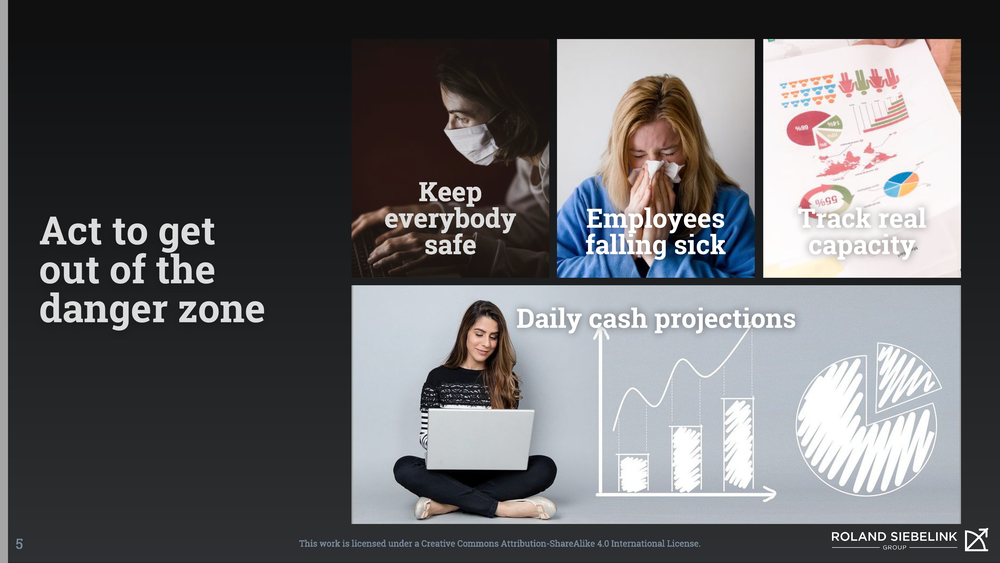
Second, act fast to get out of the danger zone. There are sorts of actions that this crisis team can come up with without much effort. And there is asheet with crisis team actions, that you can download from our website, with suggested actions that most crisis teams in these generic situations have come up with.
Keep everybody safe
The first action is keep everybody safe, right? That means: make sure that they stay at home. If there is a pandemic going on, that they are not exposed to it as much as you can control that. Of course, definitely–as most founders have already figured out–close the offices.
Employees falling sick
Second, understand which employees fall sick. So where is your capacity actually falling short? Many of the companies that I work with have started to track their real capacity by sending out weekly surveys, not just asking “are you feeling sick or under the water?” But also “are key colleagues that you normally work with sick, or can you not count on them at this stage?”
Track real capacity
Understand where certain departments may be falling really short. Because as much as we would like to see averages round out across these different departments, typically there’ll be one or two departments that are disproportionately affected. Where you need to look for either less work or capacity mitigations.
Daily cash projections
And then also, of course, the danger zone is very much defined by the cash runway. So until you have a certain sense of stability, you’ll probably want to be doing daily cash runway projections with the latest numbers. For example, “how many sales are still coming in,” or “how many meetings are salespeople taking?” To adapt: is it minus 20%, minus 30% or minus 50% that we have to count with.
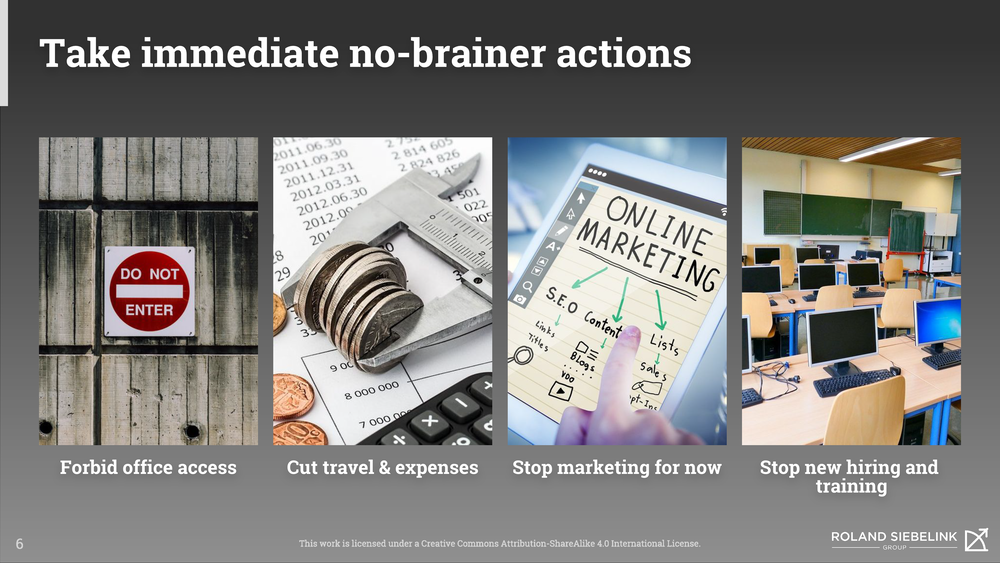
Now, in most crisis situations, there are immediate no-brainer actions that companies can take.
Forbid office access
First of all, I already mentioned, because it’s a pandemic, you want to forbid office access. Everyone has to work from home. You do not want your office to become one of these places where people actually contract the disease.
Cut travel & expenses
In terms of cost savings, as well as reducing the chance of people getting infected, you definitely want to cut any travel or gatherings, including most customer meetings. Everything has to move, of course, to virtual situations. And cutting travel is also a classic way of saving costs really fast. Some industries have even had a tradition of giving people really low salaries, but really high expense budgets so that when the tables turn, they can cut the expenses much more easily than they can cut salaries.
Stop marketing for now
Another classic area that you probably want to stop is marketing. Now, many marketers will tell you it’s exactly in these times that you have to invest in marketing because there is no competition. And yes, that is right. But I would say that’s more at the end of this C.R.I.S.I.S. framework, when you have already made some initial cost cuts and when you know where you want to make a new impact.
At this stage, you want to stop marketing campaigns, not just for the savings, but also because a lot of the messages that you were sending out, before the crisis hit, will simply not be appropriate anymore. So it’s more like pressing a reset button. Stop it for a while and then be ready to start spending again once you are a little bit through this initial crisis assessment.
Stop new hiring and training
And, as part of that, typically you want to stop new hiring and you want to stop big training sessions that you have planned for. Both from a cost perspective as well as from a reset perspective. Do your really still need all those new hires? Will you need the capacity overall? Or maybe you will even need a new sense of focus. Hires that looked ideal right now may not look ideal anymore two to three months down the line.
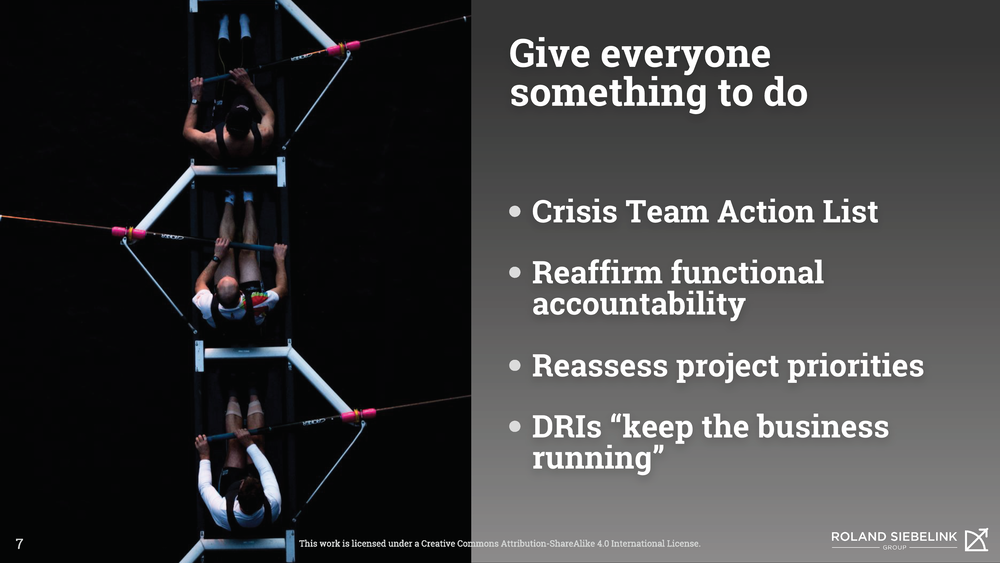
Fourth, give everyone something to do. This starts with your crisis team.
Crisis Team Action List
I’m hoping that you’ve already collected three or four people, maybe five in your crisis team. Make sure that everyone in that team, typically meeting daily, has something to deliver every day. This builds momentum. It’s a general technique that we use in many different teams as well in our daily huddles. But in a crisis team in particular, because you want to meet on a daily basis, it will really help build that momentum and the trust that people have in “we can actually deal with this crisis.”
Reaffirm functional accountability
Now for all the people outside of the crisis team, I would always start with reaffirming the functional accountability.
So for the Sales leader, it’s still about following up on all the customers, having meetings with them, even if they have to be through Zoom.
For the Customer Success leader, it’s still about making sure customers get online, that they get their check-ins.
For Engineering it’s to keep the systems running.
“Keep the business running” may still be the instruction you want to give. It’s still important to reaffirm that. Even if the world around us is completely stopping, tell people what you want them to continue doing.
Reassess project priorities
For specific projects that are on-going, whether these are quarterly rocks or annual OKRs or other big projects that are going on: ask the project leaders, one, we want to keep it running for now, but also be honest and reassess the priority of this project in the overall picture.
Projects are typically about making big changes to the company and moving a needle up in significant ways. And sometimes that’s in a direction that’s no longer apt.
For example, I would at this point in time, probably refrain from a strategic priority to start entering a new market or launching a new product or something like that. These things are probably not the most apt at this stage.
So ask these project leaders to reassess the priorities. Have them come back to you with an assessment as to whether that project should still be continued, whether it should be deferred or whether or it should be canceled altogether.
DRIs “keep the business running”
And finally, for all the directly responsible individuals. Most companies have a list of many activities that need to keep going on a weekly or a monthly basis. In most cases, we want to tell those people, keep the business running, stay on top of your daily, weekly, monthly tasks until further notice.
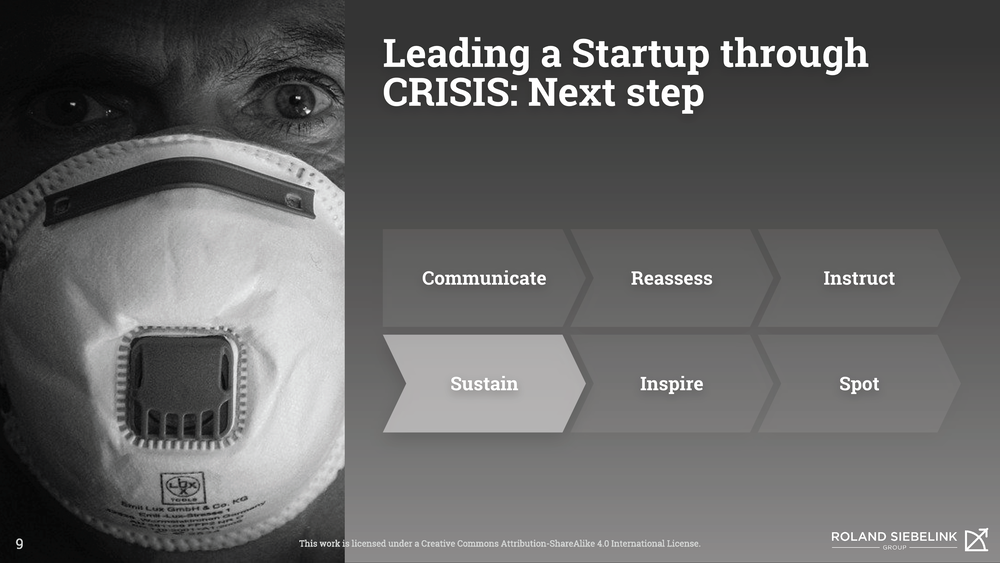
And as for the notice, this will be something we discuss in the next step: Sustaining the business.
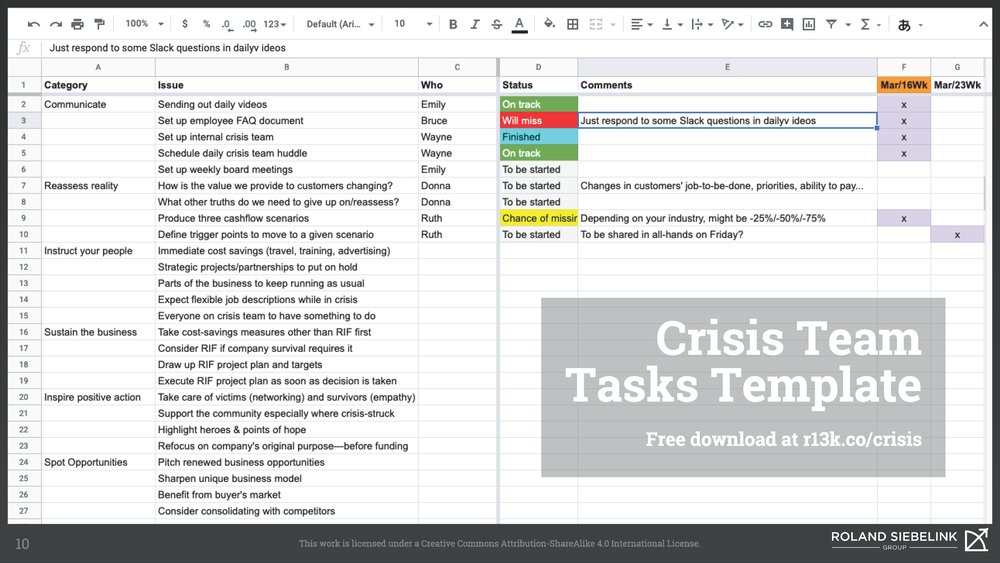
To get started right away with bridging the crisis in your startup, go to crisis. We put together all resources there that we’ve mentioned in this video: The crisis action plan, a one page crisis bridging plan, other videos, and more.